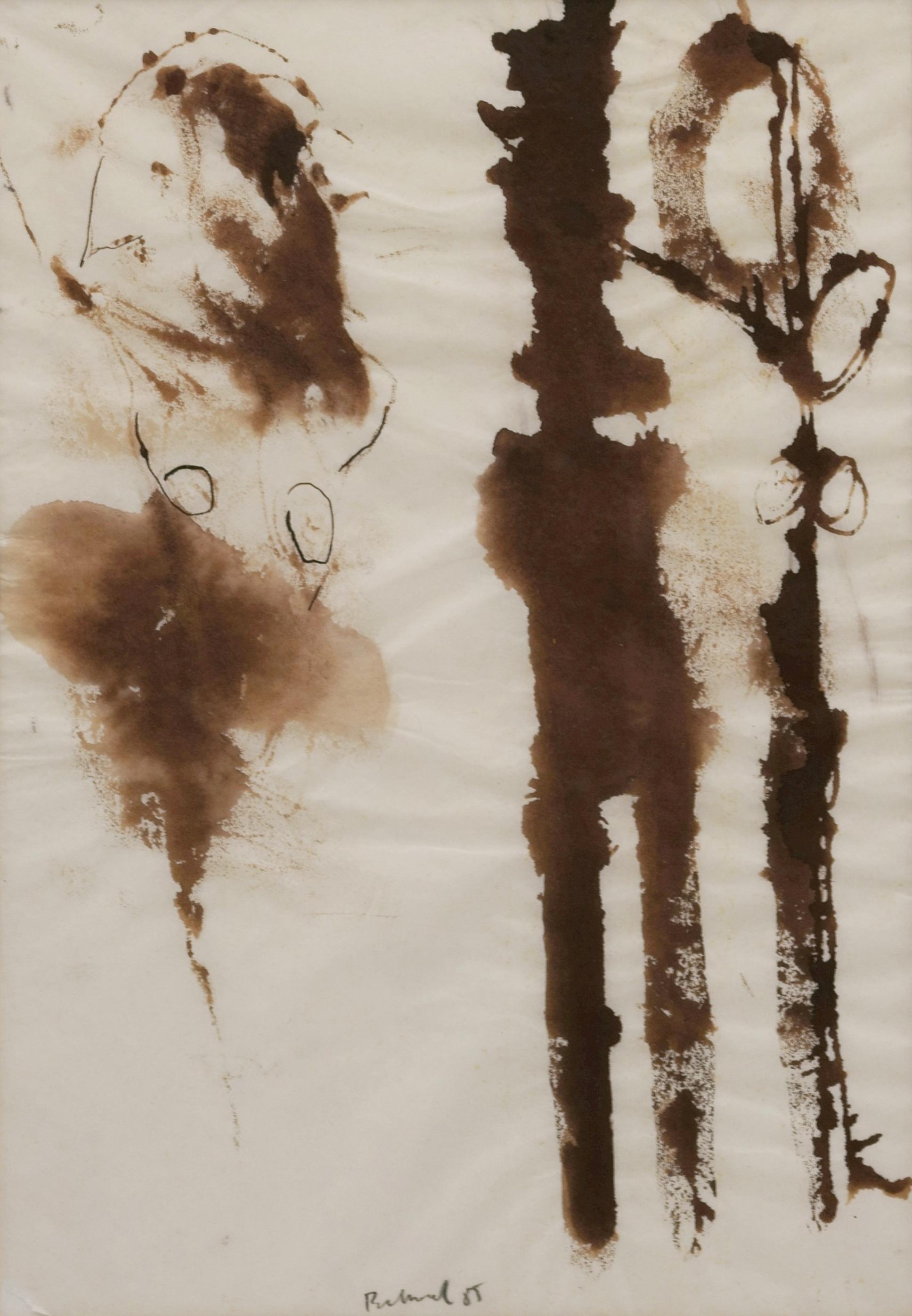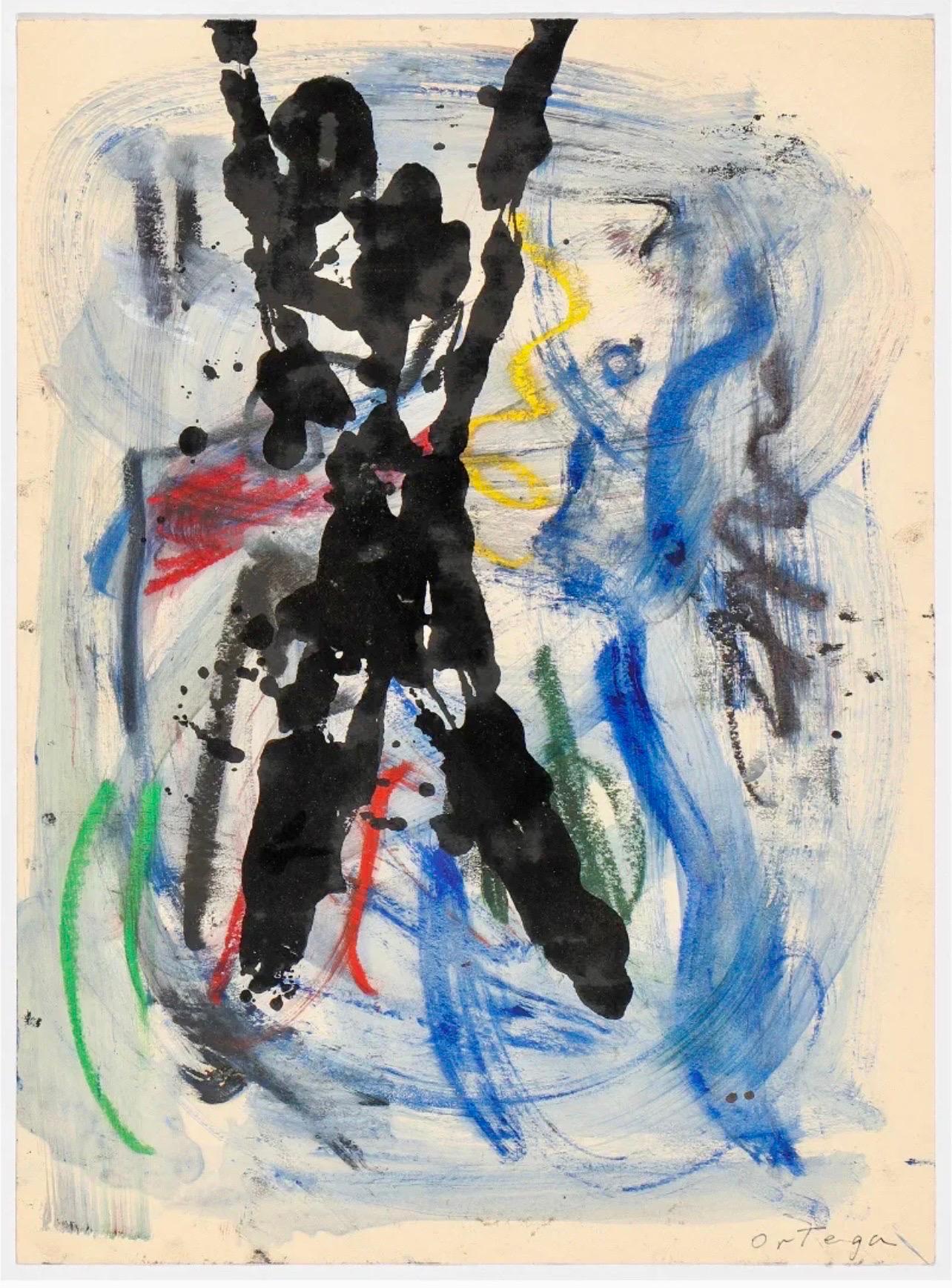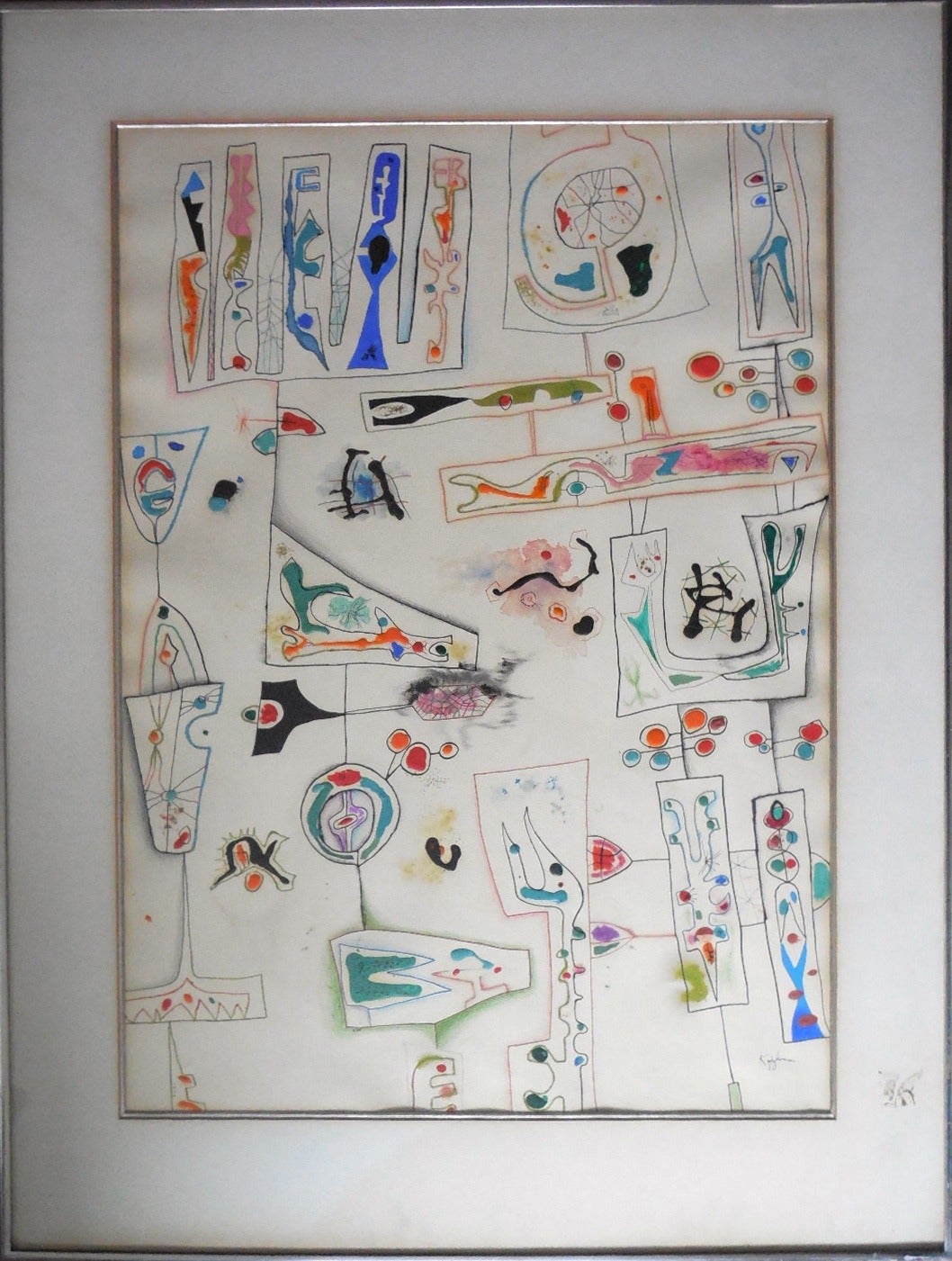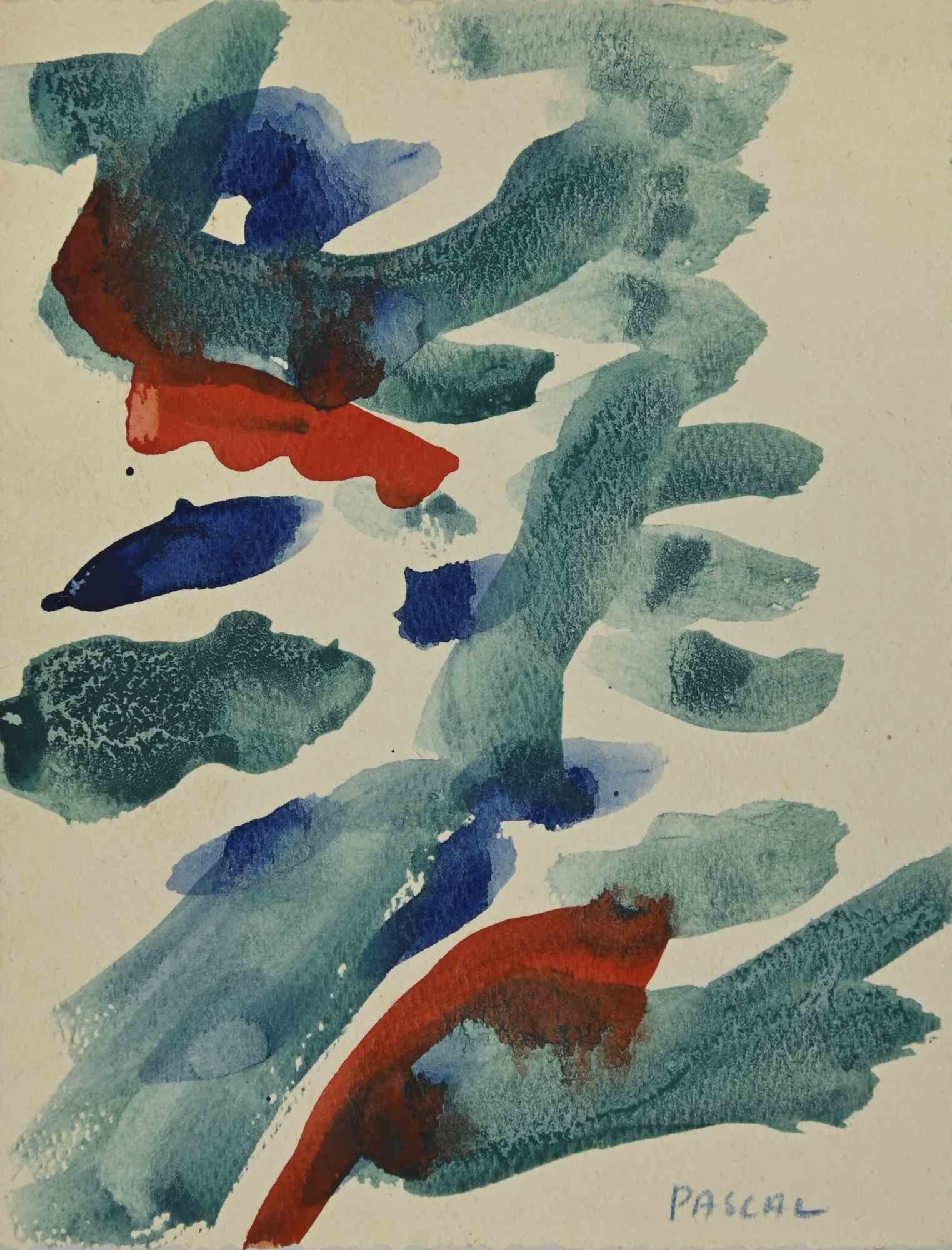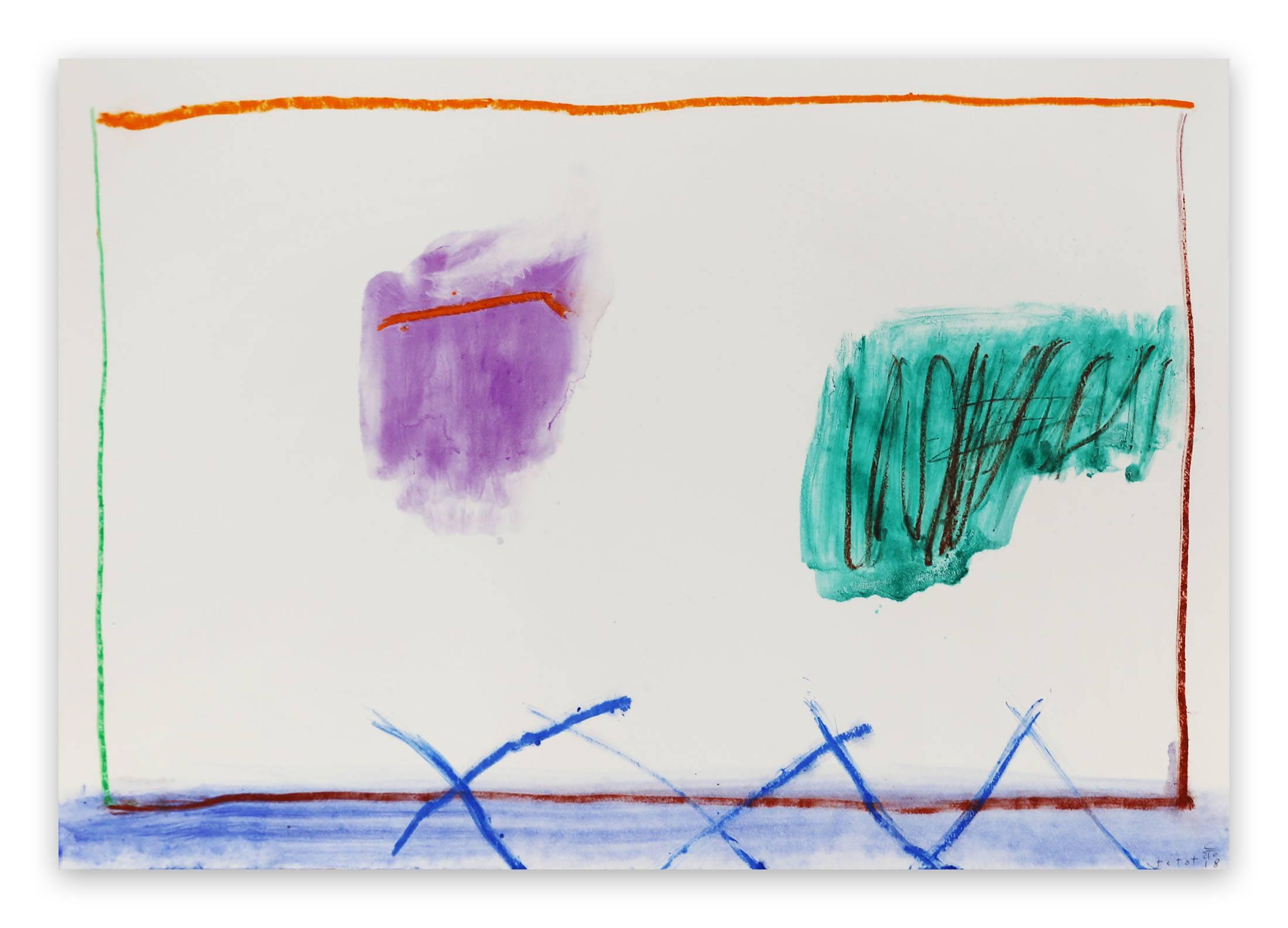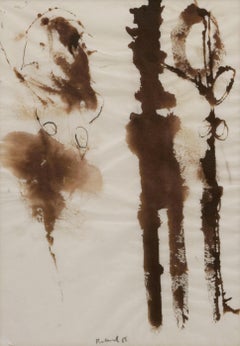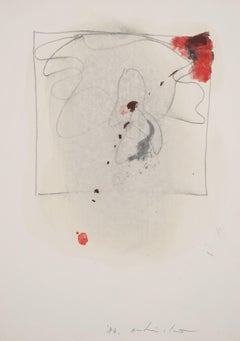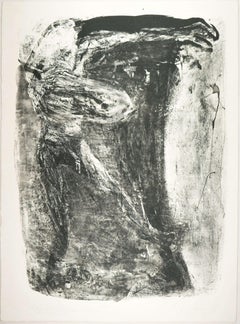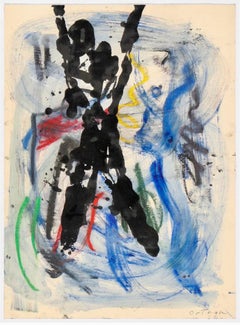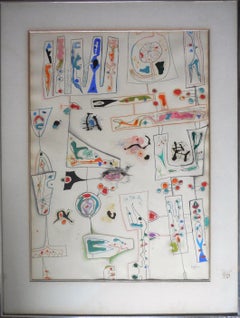Items Similar to Figurative Composition / - Expressive Signs -
Want more images or videos?
Request additional images or videos from the seller
1 of 6
Max NeumannFigurative Composition / - Expressive Signs -c. 1970
c. 1970
$659.31
£489.78
€550
CA$915.53
A$999.06
CHF 524.02
MX$12,133.88
NOK 6,545.33
SEK 6,185.66
DKK 4,187.09
About the Item
Max Neumann (* 1949 Saarbrücken) and Eta Bender (*1948 Heidelberg), Figurative Composition, around 1970. Mixed media on tracing paper, mounted on thin backing paper, 29.6 cm x 21 cm, signed “Eta Bender” and “Max Neumann” in pink and orange brush upper right and inscribed in pencil below the image.
- in good condition
- Expressive Signs -
At the lower edge of the painting, a red figure has prostrated himself in an attitude of worship. At the top, a red figure appears like an idol in front of a blue background. Characters dissolved in streaks of color are in the middle, and the numbers 30 to 40, initiated with a stamp, are on the right edge. These numbers have the same colorfulness as the dissolved characters. This rare collaboration between Max Naumann and Eta Bender establishes a network of references that is as mysterious as it is significant, carried by the expressive energy of the figures. Both artists have incorporated their names into the artwork.
About the artist
Max Neumann is one of the most notable contemporary figurative artists.
He began his studies at the Werkkunstschule Saarbrücken in 1969 and transferred to the Kunstakademie Karlsruhe the following year. In 1974, he transferred again, this time to the Berlin Academy of Fine Arts, where he graduated in 1976 as a master student of Martin Engelman. Following his first solo exhibition at Georg Nothelfer's gallery in Berlin, Neumann gained international recognition. Leading galleries in Cologne, Madrid, and Paris now represent the artist, whose work has been shown in over 150 solo exhibitions. In the mid-1970s, Neumann adopted an artistic method that he has consistently practiced independently of the trends of his time. He intuitively creates a pictorial structure with watery colors, which he then consciously forms.
Due to his interest in literature, Neumann cultivated friendly relationships with numerous writers. He illustrated Cees Nooteboom's poetry collection Abschied, published in 2021.
Throughout his career, Max Neumann has received numerous awards. In 1982, he received the Charlottenburg Art Prize; in 1983, he won the BDI Prize; in 1984, he received the Rubens Prize sponsorship award from the City of Siegen; in 1986, he was awarded the Villa Romana Scholarship; in 1991, he won the Art Prize of the Artists in Düsseldorf; in 2003, he received the Iserlohn Art Prize; and in 2004, he won the Grand Prix of the Prince of Monaco.
GERMAN VERSION
Max Neumann (* 1949 Saarbrücken) und Eta Bender (*1948 Heidelberg), Figurative Komposition, um 1970. Mischtechnik auf Transparentpapier, auf dünnes Unterlagepapier montiert. 29,6 cm x 21 cm, oben rechts mit Pinsel in Rosa und Orange mit „Eta Bender“ und „Max Neumann“ signiert und unterhalb der Darstellung mit Bleistiftwidmung versehen.
- in gutem Zustand
- Expressive Zeichen -
Am unteren Bildrand hat sich eine rote Figur in Anbetungshaltung niedergeworfen, während oben eine ebenfalls rote Figur wie ein Götze vor einem blauen Fond erscheint. Mittig sind in Farbschlieren aufgelöste Schriftzeichen zu sehen und am rechten Rand die mit einem Stempel initiierten Zahlen von 30 bis 40 aufgelistet, die dieselbe Farbigkeit aufweisen wie die zur Auflösung gebrachten Schriftzeichen. In dieser raren Zusammenarbeit zwischen Max Naumann und Eta Bender wird ein so geheimnisvoll wie bedeutsam wirkendes Bezugsgeflecht etabliert, das von der expressiven Energie der Figuren getragen wird. Dabei haben beide Künstler ihre Namen als Teil des Kunstwerks ins Bild eingefügt.
zum Künstler
Max Neumann zählt zu den herausragenden Vertretern der zeitgenössischen figurativen Kunst.
Nach einem 1969 begonnenen Studium an der Werkkunstschule Saarbrücken wechselte er 1970 an die Kunstakademie Karlsruhe und von dort 1974 an die Berliner Hochschule der Bildenden Künste, wo er sein Studium 1976 als Meisterschüler von Martin Engelman abschloss. Nach der ersten Einzelausstellung in der Berliner Galerie von Georg Nothelfer erlangte Max Neumann zunehmend internationale Anerkennung. Führende Galerien in Köln, Madrid und Paris vertreten den Künstler, dessen Werke inzwischen auf mehr als 150 Einzelausstellungen gezeigt worden sind. Mitte der 70er Jahre hat er sich eine künstlerische Methode angeeignet, die er unabhängig von den Strömungen seiner Zeit konsequent praktiziert. Dabei schafft er in einem intuitiven Akt mit wässrigen Farben eine Bildstruktur, die dann bewusst ausgeformt wird.
Aufgrund seines literarischen Interesses pflegt Neumann mit zahlreichen Schriftstellern ein freundschaftliches Verhältnis. Er illustrierte Cees Nootebooms 2021 erschienenen Gedichtband ‚Abschied‘.
Max Neumann ist über seine ganze Karriere hinweg mit zahlreichen Preisen ausgezeichnet worden. So erhielt er beispielsweise 1982 den Charlottenburger Kunstpreis, 1983 war er Preisträger des BDI, 1984 erhielt er den Förderpreis zum Rubenspreis der Stadt Siegen, 1986 wurde er mit dem Stipendium Villa Romana ausgezeichnet, 1991 wurde ihm der Kunstpreis der Künstler in Düsseldorf verliehen, 2003 erhielt er den Iserlohner Kunstpreis und 2004 den Grand Prix des Prinzen von Monaco.
- Creator:Max Neumann (1949, German)
- Creation Year:c. 1970
- Dimensions:Height: 11.42 in (29 cm)Width: 8.27 in (21 cm)Depth: 0.4 in (1 cm)
- Medium:
- Movement & Style:
- Period:
- Condition:
- Gallery Location:Berlin, DE
- Reference Number:1stDibs: LU2438216531292
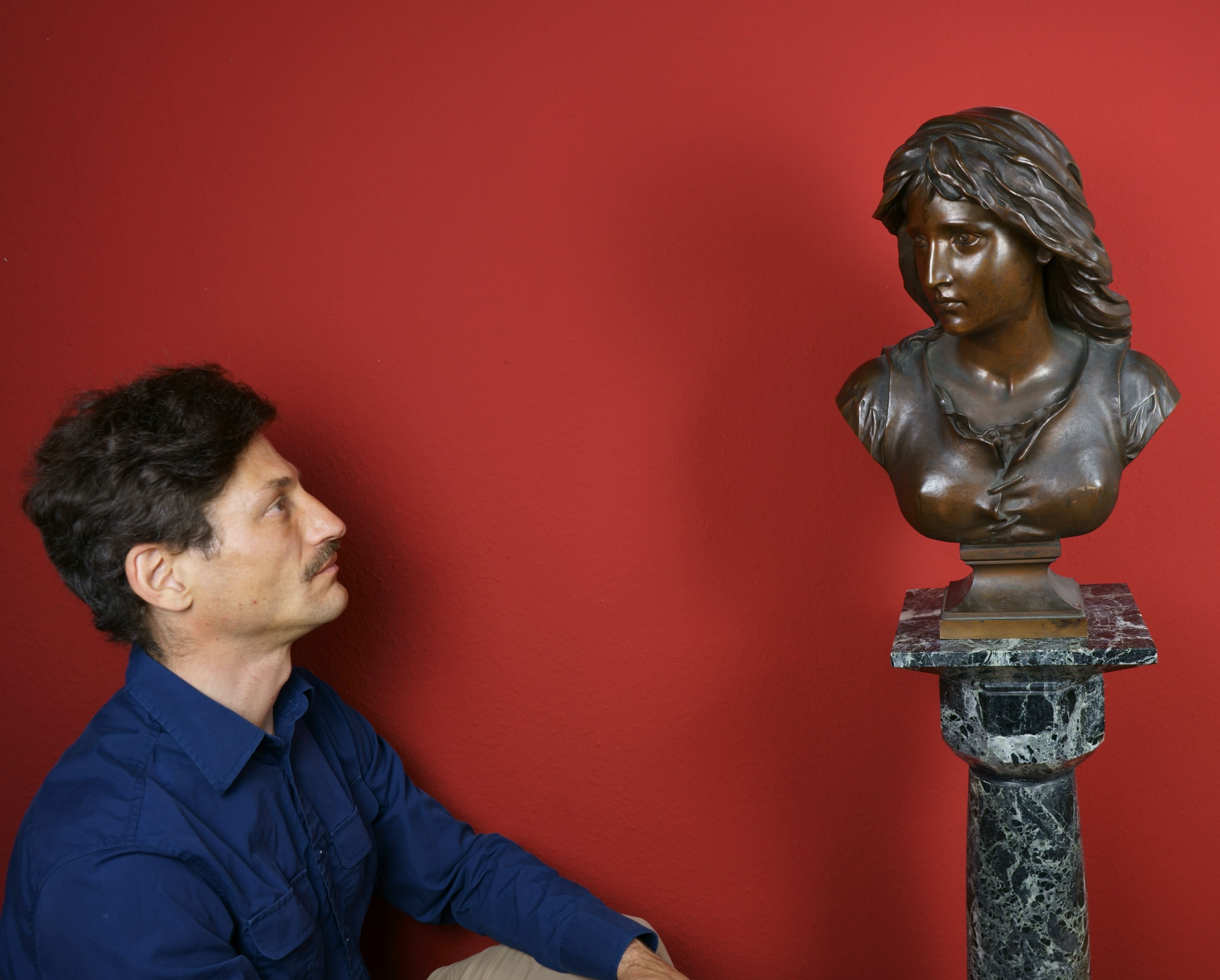
About the Seller
5.0
Vetted Professional Seller
Every seller passes strict standards for authenticity and reliability
Established in 2014
1stDibs seller since 2023
21 sales on 1stDibs
- ShippingRetrieving quote...Shipping from: Berlin, Germany
- Return Policy
Authenticity Guarantee
In the unlikely event there’s an issue with an item’s authenticity, contact us within 1 year for a full refund. DetailsMoney-Back Guarantee
If your item is not as described, is damaged in transit, or does not arrive, contact us within 7 days for a full refund. Details24-Hour Cancellation
You have a 24-hour grace period in which to reconsider your purchase, with no questions asked.Vetted Professional Sellers
Our world-class sellers must adhere to strict standards for service and quality, maintaining the integrity of our listings.Price-Match Guarantee
If you find that a seller listed the same item for a lower price elsewhere, we’ll match it.Trusted Global Delivery
Our best-in-class carrier network provides specialized shipping options worldwide, including custom delivery.More From This Seller
View AllUntitled / - Association -
Located in Berlin, DE
Detlef Baltrock (*1954 Stuttgart), Untitled, 1985. Watercolor, 29.5 cm x 21 cm (visible dimensions), 41 cm x 32 cm (frame), signed “Baltrock” lower center and signed “[19]85”, label ...
Category
1980s Abstract Expressionist Abstract Drawings and Watercolors
Materials
Paper
Rare Animal / - Abstract figuration -
Located in Berlin, DE
Veit Hofmann (*1944 Dresden), Rare Animal, 1987. Oil on light card, 42 cm (height) x 30 cm (width), monogrammed “V[eit]H[ofmann]” lower right and dated “[19]87”, titled “Seltenes Tie...
Category
1980s Abstract Expressionist Abstract Paintings
Materials
Oil
Untitled / - Bleeding Picture -
Located in Berlin, DE
Ouhi Cha (*1945 Busan), Untitled, 1988. mixed media, 31.8 cm x 23.3 cm (sheet size), signed “Ouhi Cha” in pencil below and dated “[19]88”.
- in good condition
- Bleeding Picture -...
Category
1980s Abstract Abstract Drawings and Watercolors
Materials
Paper
My treasure, my sanctuary / - A Tortured Treasure -
Located in Berlin, DE
Johannes Heisig (*1953 Leipzig), "My treasure, my sanctuary" - To the Christmas Oratorio by Johann Sebastian Bach. Lithograph on strong yellowish laid paper with watermark, 53 x 39.5...
Category
1980s Abstract Expressionist Figurative Prints
Materials
Lithograph
$364 Sale Price
20% Off
Threatening to defeat me once and for all / - A Christmas Pietà -
Located in Berlin, DE
Johannes Heisig (*1953 Leipzig), "Threatening to defeat me once and for all" - To the Christmas Oratorio by Johann Sebastian Bach. Lithograph on strong yellowish laid paper with wate...
Category
1980s Abstract Expressionist Figurative Prints
Materials
Lithograph
$365 Sale Price
20% Off
Tectonic Tension / - Archetypes of Painting -
Located in Berlin, DE
Jürgen Möbius (*1939 Großenhain), Tectonic Tension. Oil on hardboard, 47.5 x 60 cm, 49 x 61.5 cm (frame), signed lower right "Möbius" and dated "[19]81".
- Upper left corner with a small chip, light scratches and a little rubbed in places. Provisional gallery frame with traces of use.
- Archetypes of Painting -
About the artwork
The form structure in front of the eye is overlapped by the frame. Thus, the frame does not open up a space in which something is presented, but rather shows the seemingly arbitrary section of a comprehensive context that cannot be framed as such.
We see forms that stand in a structure of tension with each other, whereby the individual black and brown forms, which continue almost endlessly beyond the frame, already show a tension in themselves, since they are not only forms, but also surfaces - form surfaces, while the light blue surface ground is at the same time forms that appear as surface forms. The formed surfaces and surface forms are nested within each other and form a structure that encompasses all elements.
The angular arrangement of the black and brown shaped surfaces gives the structure a tectonic character. The tension is thus heightened to the point of paradox, since the black shape at the front is overlapped by the brown shape at the bottom in the center of the picture, which would be impossible in real space. It is precisely through this "paradox" that Möbius demonstrates that the paradoxical is reality within painting. It is, so to speak, the most original possibility of painting, which distinguishes it from the other arts. In combination with the tectonic formations, Jürgen Möbius creates an archaic primordial painting, which, however, should not be confused with the autonomous color and form cosmos of Suprematism à la Kasimir Malevich. Instead of homogeneous, perfectly colored forms, here the colors are deliberately applied unevenly, and the light blue is mixed with the brown in a manner determined by the brushstroke. At the edges of the surface forms, the uneven application of paint allows the wood of the unprimed hardboard to show through. In this way, Möbius illustrates that we are dealing with a painting that has been created by an act of painting - an act, however, that takes hold of the original principles of painting and thus realizes painting as such.
About the artist
From 1959 to 1965 Jürgen Möbius studied painting at the University Institute for Art and Work Education in Mainz. He also studied philosophy and art history at the University of Mainz. Afterwards he worked as a freelance artist in Mainz.
At first, Möbius created material reliefs and installations, then, around 1974, he turned increasingly to conceptual art and added cinematic means. During this phase he wrote the manifesto-like essay "Principles of Supranatural Landscape" (1979).
From 1981 on, Möbius concentrated on painting and searched for artistic ways to "treat intellectual and sensual perception equally in the fusion of representational and abstract pictorial elements" (Wolfgang Zemter). He found inspiration on his study trips to Thailand and Sri Lanka.
"The pure painting of Jürgen Möbius flows through us as a timeless expression of memory and energy, ploughing our perception and bringing us the happiness of seeing authentic, immovable form.
- Philippe Büttner
Selection of solo exhibitions
1969 Galerie Würzner, Düsseldorf / Galerie Gurlitt, Mainz
1972 Städtische Galerie, Mainz
1973 Galerie Schloss Ringenberg Rathaus, Kleve
1974 Röderhausmuseum, Wuppertal
1976 Galerie Glasing, Osnabrück / Städtische Galerie, Herne
1977, 1997, 2004 Märkisches Museum, Witten
1979 Studio M, Bamberg / Staatstheater, Darmstadt
1980 Galerie Stolànovà, Wiesbaden / Mittelrheinmuseum, Koblenz
1982 Galerie Dornhöfer, Mainz
1984 Galerie Neumühle, Schlangenbad
1985 Landesmuseum, Mainz / Kunstverein, Ludwigshafen / Nassauischer Kunstverein, Wiesbaden
1986 Museum, Bochum / Galerie der Stadt Iserlohn
1987, 1990 Galerie Klaus Kiefer, Essen
1987, 2000 Galerie Ulrike Buschlinger, Wiesbaden
1988 Kunsthalle Darmstadt
1988, 1992, 1996, 1999 Galerie Leonhard, Basel
1992, 2002 Galerie Zulauf, Freisheim
1994 Galerie Remy, Vallendar
1995 Sendezentrum des Zweiten Deutschen Fernsehens, Mainz
2001 Collegium oecumenicum, Bamberg / MVB Forum für Kultur und Wirtschaft, Mainz
2006 Adam Gallery, London
Selection of group exhibitions
1969 ‘International Graphic Arts’, Galerie Dalléas Bordeaux, Paris
1975 ‘Deutscher Künstler-Bund’, Dortmund
1979 ‘Man and man’s Images’, Märkisches Museum Witten
1980 ‘Love-Dokuments of our Time’, Art Hall Darmstadt and Art Association Hannover
1982 ‘Work - Progress – Position’, Nassau Art Association Wiesbaden
1983 ‘Principle Hope – Utopic Aspects in Art and Culture of the 20th Century’, Museum Bochum
1986 ‘Selfportraits’, Gallery Klaus Kiefer Essen
1987 ‘The Dying and Death’, Gallery Klaus Kiefer Essen
1989 ‘Where are You, Revolution – Freedom, Liberty, Egality, Fraternity to-day’, Museum Bochum 1990 ‘Flight – a Problem within the Memory of Man’, Kunsthalle Darmstadt ‘Art and War 1939 – 89’, House of Cultures Berlin
1991 ‘Material and Form’, Pillnitz Castle Dresden and Pfalz Gallery Kaiserslautern
1995 20 Years Exhibitions, Chrämerhuus Langenthal, Schweiz
1998 ‘Works on Paper’, Klaus Kiefer Gallery Essen
2000 ‘Acquisitions 1900 – 2000’, Mittelrhein-Museum Koblenz
2001 ‘Strange Pictures’, Klaus Kiefer Gallery Essen
2002 ‘10 Years Buschlinger Gallery’, Buschlinger Gallery Wiesbaden
2004 ‘Eternal Space – Pictures and Sculptures’, Dome of Bamberg
2005 Art Fair Chicago, Adam Gallery, London
Selected Bibliography
Mittelrheinisches Landesmuseum (Hrsg.): Jürgen Möbius - Neue Bilder, Mainz 1985.
Kunstverein Darmstadt (Hrsg.): Jürgen Möbius. Bilder 1985 - 1988. Kunsthalle Darmstadt, 26. Juni - 14. August 1988. Red. Dorit Marhenke, Lyrik Marcus Schiltenwolf, Düsseldorf 1988.
Gabriele Prusko (Hrsg.): Jürgen Möbius. Mit Texten von Philippe Büttner und Ralph Mieritz, Basel 1992.
Wolfgang Zemter (Hrsg.): Jürgen Möbius - Aktuelle Arbeiten. Märkisches Museum der Stadt Witten, Bönen 1999.
Wolfgang Zemter (Hrsg.): Jürgen Möbius. Flieger in meinem Zimmer und Beruhigte Zone, Bönen 2004.
Dama Gallery...
Category
1980s Abstract Abstract Paintings
Materials
Oil
$1,342 Sale Price
20% Off
You May Also Like
Alfred Ortega Bold Figurative Abstract Expressionist Oil Monoprint Painting
Located in Surfside, FL
Alfred Ortega (American, 20th C.)
Abstract Monoprint with wash
Ghost of Champs-Élysées (Paris, France)
Born in Philadelphia, Alfred Ortega studied painting and sculpture at the Pe...
Category
20th Century Abstract Paintings
Materials
Oil, Monoprint
Untitled
By Lawrence Kupferman
Located in Surfside, FL
30X21.25 without the frame. Mixed Media painting and drawing on paper. Lawrence Kupferman had a long and illustrious career as an artist and educator. His work has been exhibited at ...
Category
20th Century Abstract Expressionist Abstract Drawings and Watercolors
Materials
Paper, Mixed Media
Abstract composition - Drawing by Pascal - 1960
Located in Roma, IT
Abstract composition is an artwork realized by Pascal, in 1960.
Watercolour, 13 x 10 cm.
Handsigned in the lower right margin.
Good conditions
Category
Early 20th Century Modern Abstract Drawings and Watercolors
Materials
Paper, Watercolor
Untitled 4 (Abstract painting)
By Claude Tétot
Located in London, GB
Acrylic and oil on paper - Unframed
Claude Tétot is a French abstract artist whose work expresses harmony in disharmony by exploring the enigmatic unity that can exist between seemi...
Category
2010s Abstract Expressionist Abstract Drawings and Watercolors
Materials
Paper, Oil, Acrylic
Untitled 4 (Abstract Painting)
By Claude Tétot
Located in London, GB
Untitled 4 (Abstract Painting)
Acrylic and oil on paper - Unframed
Claude Tétot is a French abstract artist whose work expresses harmony in disharmony b...
Category
2010s Abstract Expressionist Abstract Drawings and Watercolors
Materials
Paper, Oil, Acrylic
Untitled 4 (Abstract Painting)
By Claude Tétot
Located in London, GB
Untitled 4 (Abstract Painting)
Acrylic and oil on paper - Unframed
Claude Tétot is a French abstract artist whose work expresses harmony in disharmony by exploring the enigmatic un...
Category
2010s Abstract Expressionist Abstract Drawings and Watercolors
Materials
Paper, Oil, Acrylic
